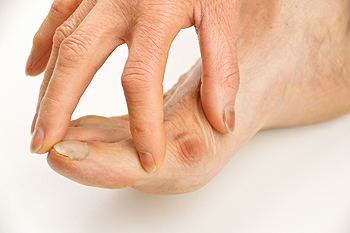 When the foot incurs abnormal pressure from wearing incorrect footwear, a corn may develop. A corn is a small area of thickened skin, usually appearing on the tops of the toes or the balls of the feet. These are typically referred to as hard corns, often producing redness, swelling, and pain. Soft corns are usually found between the toes, appearing white and having a rubbery texture. Both types of corns are produced by excessive friction, typically caused by wearing ill fitting shoes and from moisture accumulating between the toes. Many people will develop corns throughout their lives, and it is one of the most common foot ailments. It’s important to prevent corns from developing by being aware of specific areas of the foot that often endure pressure. If you stand for most of the day, it’s suggested to take ample time to find shoes that fit properly. Additionally, the skin will benefit significantly by being moisturized. Please consult with a podiatrist for a proper diagnosis and information on how painful corns can be removed.
When the foot incurs abnormal pressure from wearing incorrect footwear, a corn may develop. A corn is a small area of thickened skin, usually appearing on the tops of the toes or the balls of the feet. These are typically referred to as hard corns, often producing redness, swelling, and pain. Soft corns are usually found between the toes, appearing white and having a rubbery texture. Both types of corns are produced by excessive friction, typically caused by wearing ill fitting shoes and from moisture accumulating between the toes. Many people will develop corns throughout their lives, and it is one of the most common foot ailments. It’s important to prevent corns from developing by being aware of specific areas of the foot that often endure pressure. If you stand for most of the day, it’s suggested to take ample time to find shoes that fit properly. Additionally, the skin will benefit significantly by being moisturized. Please consult with a podiatrist for a proper diagnosis and information on how painful corns can be removed.
If you have any concerns regarding your feet and ankles, contact Dr. Steven Shlonsky of Louisville, Kentucky. Dr. Shlonsky will treat your foot and ankle needs.
Corns: What Are They? and How Do You Get Rid of Them?
Corns can be described as areas of the skin that have thickened to the point of becoming painful or irritating. They are often layers and layers of the skin that have become dry and rough, and are normally smaller than calluses.
Ways to Prevent Corns
There are many ways to get rid of painful corns such as wearing:
Treating Corns
Treatment of corns involves removing the dead skin that has built up in the specific area of the foot. Consult with Dr. Shlonsky to determine the best treatment option for your case of corns.
If you have any questions please feel free to contact our office located in Louisville, KY . We offer the newest diagnostic and treatment technologies for all your foot and ankle needs.
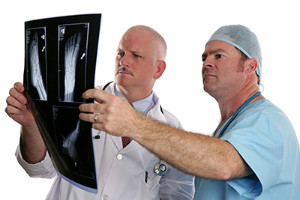 A broken foot typically occurs from a fall or repeated activities that put stress on the foot. If your child complains of pain, swelling, and bruising, the chances are high that the foot is broken. To properly diagnose this condition, an x-ray, CAT scan, or MRI is typically taken, depending on the severity of the break. Once the broken foot is confirmed, treatment may consist of wearing a cast, which restricts movement in the leg and therefore allows healing to occur. Additional treatment suggestions include resting and elevating the foot by utilizing pillows. This may be beneficial in reducing any swelling that’s present. Obtaining a tetanus shot may be considered if the skin on the foot has cuts from the injury. A podiatrist is trained to handle a broken foot and should be contacted immediately if you suspect your child has suffered one.
A broken foot typically occurs from a fall or repeated activities that put stress on the foot. If your child complains of pain, swelling, and bruising, the chances are high that the foot is broken. To properly diagnose this condition, an x-ray, CAT scan, or MRI is typically taken, depending on the severity of the break. Once the broken foot is confirmed, treatment may consist of wearing a cast, which restricts movement in the leg and therefore allows healing to occur. Additional treatment suggestions include resting and elevating the foot by utilizing pillows. This may be beneficial in reducing any swelling that’s present. Obtaining a tetanus shot may be considered if the skin on the foot has cuts from the injury. A podiatrist is trained to handle a broken foot and should be contacted immediately if you suspect your child has suffered one.
A broken foot requires immediate medical attention and treatment. If you need your feet checked, contact Dr. Steven Shlonsky from Louisville, Kentucky. Dr. Shlonsky can provide the care you need to keep you pain-free and on your feet.
Broken Foot Causes, Symptoms, and Treatment
A broken foot is caused by one of the bones in the foot typically breaking when bended, crushed, or stretched beyond its natural capabilities. Usually the location of the fracture indicates how the break occurred, whether it was through an object, fall, or any other type of injury.
Common Symptoms of Broken Feet:
Those that suspect they have a broken foot shoot seek urgent medical attention where a medical professional could diagnose the severity.
Treatment for broken bones varies depending on the cause, severity and location. Some will require the use of splints, casts or crutches while others could even involve surgery to repair the broken bones. Personal care includes the use of ice and keeping the foot stabilized and elevated.
If you have any questions please feel free to contact our office located in Louisville, KY . We offer the newest diagnostic and treatment technologies for all your foot and ankle needs.
 The purpose of the Achilles tendon is to connect the calf muscle to the heel bone. It is the longest tendon in the body, and walking or running would be impossible to accomplish without it. There are several causes for Achilles tendon pain, including inflammation of the tendon, known as tendonitis, or a tear occurring due to sudden movement, often causing severe pain. Surgery may be required to repair the tendon if the patient is unable to walk or stand. Other symptoms may include swelling, stiffness, and reduced strength in addition to experiencing a limited range of motion. There may be several factors which may increase the possibility of an Achilles tendon injury, including a change in the playing surface or an increase in training for athletes. If you think you may have this condition, a podiatrist will be able to help.
The purpose of the Achilles tendon is to connect the calf muscle to the heel bone. It is the longest tendon in the body, and walking or running would be impossible to accomplish without it. There are several causes for Achilles tendon pain, including inflammation of the tendon, known as tendonitis, or a tear occurring due to sudden movement, often causing severe pain. Surgery may be required to repair the tendon if the patient is unable to walk or stand. Other symptoms may include swelling, stiffness, and reduced strength in addition to experiencing a limited range of motion. There may be several factors which may increase the possibility of an Achilles tendon injury, including a change in the playing surface or an increase in training for athletes. If you think you may have this condition, a podiatrist will be able to help.
Achilles tendon injuries need immediate attention to avoid future complications. If you have any concerns, contact Dr. Steven Shlonsky of Louisville, Kentucky. Dr. Shlonsky can provide the care you need to keep you pain-free and on your feet.
What Is the Achilles Tendon?
The Achilles tendon is a tendon that connects the lower leg muscles and calf to the heel of the foot. It is the strongest tendon in the human body and is essential for making movement possible. Because this tendon is such an integral part of the body, any injuries to it can create immense difficulties and should immediately be presented to a doctor.
What Are the Symptoms of an Achilles Tendon Injury?
There are various types of injuries that can affect the Achilles tendon. The two most common injuries are Achilles tendinitis and ruptures of the tendon.
Achilles Tendinitis Symptoms
Rupture Symptoms
Treatment and Prevention
Achilles tendon injuries are diagnosed by a thorough physical evaluation, which can include an MRI. Treatment involves rest, physical therapy, and in some cases, surgery. However, various preventative measures can be taken to avoid these injuries, such as:
If you have any questions please feel free to contact our office located in Louisville, KY . We offer the newest diagnostic tools and technology to treat your foot and ankle needs.
 Friction is generally the leading cause of blisters occurring on the feet. The majority of them are filled with a clear fluid; however, if an infection occurs, it may appear to have a yellowish hue. Typically, wearing ill-fitting shoes may cause friction on the skin, usually developing during repetitive motions like running and walking at moderate speeds. Some other causes of blisters may originate from severe burns or tissue damage caused by frostbite, while certain medical conditions including eczema can be linked to blisters on the feet. Treatment may include wearing shoes that fit comfortably without having the toes rub together. You can also apply a gauze pad for protection. If this option is chosen, infection may be avoided by changing the dressing regularly. Relief will be desired if extreme discomfort is experienced, and the blister may need to be drained. Please consider a consultation with a podiatrist for advice and recommendations for treatments of blisters.
Friction is generally the leading cause of blisters occurring on the feet. The majority of them are filled with a clear fluid; however, if an infection occurs, it may appear to have a yellowish hue. Typically, wearing ill-fitting shoes may cause friction on the skin, usually developing during repetitive motions like running and walking at moderate speeds. Some other causes of blisters may originate from severe burns or tissue damage caused by frostbite, while certain medical conditions including eczema can be linked to blisters on the feet. Treatment may include wearing shoes that fit comfortably without having the toes rub together. You can also apply a gauze pad for protection. If this option is chosen, infection may be avoided by changing the dressing regularly. Relief will be desired if extreme discomfort is experienced, and the blister may need to be drained. Please consider a consultation with a podiatrist for advice and recommendations for treatments of blisters.
Blisters are prone to making everyday activities extremely uncomfortable. If your feet are hurting, contact Dr. Steven Shlonsky of Louisville, Kentucky. Dr. Shlonsky can provide the care you need to keep you pain-free and on your feet.
Foot Blisters
Foot blisters develop as a result of constantly wearing tight or ill-fitting footwear. This happens due to the constant rubbing from the shoe, which can often lead to pain.
What Are Foot Blisters?
A foot blister is a small fluid-filled pocket that forms on the upper-most layer of the skin. Blisters are filled with clear fluid and can lead to blood drainage or pus if the area becomes infected.
How Do Blisters Form?
Blisters on the feet are often the result of constant friction of skin and material, usually by shoe rubbing. Walking in sandals, boots, or shoes that don’t fit properly for long periods of time can result in a blister. Having consistent foot moisture and humidity can easily lead to blister formation.
Prevention & Treatment
It is important to properly care for the affected area in order to prevent infection and ease the pain. Do not lance the blister and use a Band-Aid to provide pain relief. Also, be sure to keep your feet dry and wear proper fitting shoes. If you see blood or pus in a blister, seek assistance from a podiatrist.
If you have any questions, please feel free to contact our office located in Louisville, KY . We offer the newest diagnostic and treatment technologies for all your foot care needs.
 A sedentary lifestyle may be linked to numerous health issues, including diabetes and high blood pressure. For these individuals, it may be necessary to increase the amount of time standing during the day; this may be helpful in easing potential back problems and improving posture and strength. There are many ways to incorporate standing throughout the work day, such as portioning your lunch time to include walking. Meetings that consist of walking instead of sitting around a table may be beneficial as well. Standing desks may be another option, which can help increase alertness and therefore increase productivity. Another helpful habit to acquire is using the stairs instead of an elevator, in addition to parking your car further away from the building you are entering to promote walking.
A sedentary lifestyle may be linked to numerous health issues, including diabetes and high blood pressure. For these individuals, it may be necessary to increase the amount of time standing during the day; this may be helpful in easing potential back problems and improving posture and strength. There are many ways to incorporate standing throughout the work day, such as portioning your lunch time to include walking. Meetings that consist of walking instead of sitting around a table may be beneficial as well. Standing desks may be another option, which can help increase alertness and therefore increase productivity. Another helpful habit to acquire is using the stairs instead of an elevator, in addition to parking your car further away from the building you are entering to promote walking.
While working on the feet, it is important to take the proper care of them. For more information about working on your feet, contact Dr. Steven Shlonsky from Louisville, Kentucky. Dr. Shlonsky will treat your foot and ankle needs.
Working on Your Feet
Standing on your feet for long periods of time can cause stress and pain in your feet. Your whole body may experience change in terms of posture, back pain, bunions, callouses and or plantar warts. There are ways to avoid these conditions with proper foot care, smart choices and correct posture.
Positive Changes
Negative heeled shoe – Choosing this shoe type places the heel slightly lower than the ball of the foot. These are great for overall foot health. Find shoes that fit you correctly.
Go barefoot – Our feet were not designed to be enclosed for all hours of the day. Try to periodically expose your feet to air.
Eliminate Pain
Foot Exercises – Performing simple exercises, incorporating yoga and doing stretches are beneficial. This will allow increased blood flow to the area and muscles of the foot.
Achilles tendon – Stretching the foot out flat on the floor will relax the calf muscles and tendon. These exercises can be performed almost anywhere. Make sure you add these exercises to your daily regimen.
With a little bit of this information and knowing more about foot health, you will notice changes. Foot stretches and proper footwear will help with pain and prevent further issues.
If you have any questions please feel free to contact our office located in Louisville, KY . We offer the newest diagnostic and treatment technologies for all your foot and ankle needs.
Foot care is important regardless of your profession, but those who work on their feet must pay special attention. Bunions, calluses, blisters, and plantar warts are just a few of the many conditions that can arise after standing all day. While painful at their worst, these conditions can easily be avoided with the right foot care. This includes both appropriate footwear and proper posture—important elements that affect the health of your feet.
Choosing appropriate footwear means choosing a shoe that has a negative heel. This means that the heel is slightly lower than the ball of your foot, which places less of a strain. If you have a profession that requires you to be on your feet all day, investing in a pair of high-quality shoes is pertinent. High-quality shoes can be purchased from a respected manufacturer that emphasizes foot care and foot health.
Despite the regularity of wearing shoes, the feet are naturally not designed to be enclosed. Regular “barefoot” time for your feet can be beneficial for foot health. Among other methods, allowing your feet to breathe can help alleviate the pain and pressure your feet may be experiencing from being on your feet all day.
Simple foot exercises and yoga positions can help improve both the health and function of your feet. Active foot exercises that create movement will stimulate your foot’s blood flow and circulation, and yoga positions that place your feet flat onto the floor will stretch out their muscles. Yoga is particularly beneficial for your Achilles tendon and calf muscles, which are areas that can become especially problematic if not taken care of. Foot exercises and yoga positions can be easily performed every day at virtually any location and any time; whether it is at the office, at the gym, or at home right before you go to bed. Simple stretching can increase your foot health by miles.
The foot pain you experience after lengthy hours working on your feet may seem inevitable and unavoidable; in reality, however, that is not the case. Wearing proper footwear and performing simple foot exercises and stretches can help ease foot pain and allow you to truly avoid frustrating foot problems.
Your feet can easily be kept healthy with some education and a little effort. Pain that begins at the feet can eventually affect the whole body. Begin taking care of your feet now!
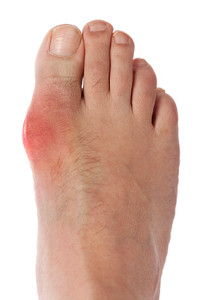 Gout results from sharp crystals being formed when there is an abundance of uric acid in the blood. The big toe is usually the first place for this to happen, although, if not treated, it may spread to other joint areas like the knee or elbow. If there is tenderness or stiffness in the joint, this could potentially be a sign of gout. Using ice on the affected joint and drinking plenty of water can help to reduce symptoms. If you think that you might have gout, a podiatrist will be able to properly diagnose you and lead you on the path to recovery and future prevention.
Gout results from sharp crystals being formed when there is an abundance of uric acid in the blood. The big toe is usually the first place for this to happen, although, if not treated, it may spread to other joint areas like the knee or elbow. If there is tenderness or stiffness in the joint, this could potentially be a sign of gout. Using ice on the affected joint and drinking plenty of water can help to reduce symptoms. If you think that you might have gout, a podiatrist will be able to properly diagnose you and lead you on the path to recovery and future prevention.
Gout is a foot condition that requires certain treatment and care. If you are seeking treatment, contact Dr. Steven Shlonsky from Louisville, Kentucky. Dr. Shlonsky will treat your foot and ankle needs.
What Is Gout?
Gout is a type of arthritis caused by a buildup of uric acid in the bloodstream. It often develops in the foot, especially the big toe area, although it can manifest in other parts of the body as well. Gout can make walking and standing very painful and is especially common in diabetics and the obese.
People typically get gout because of a poor diet. Genetic predisposition is also a factor. The children of parents who have had gout frequently have a chance of developing it themselves.
Gout can easily be identified by redness and inflammation of the big toe and the surrounding areas of the foot. Other symptoms include extreme fatigue, joint pain, and running high fevers. Sometimes corticosteroid drugs can be prescribed to treat gout, but the best way to combat this disease is to get more exercise and eat a better diet.
If you have any questions please feel free to contact our office located in Louisville, KY . We offer the newest diagnostic and treatment technologies for all your foot and ankle needs.
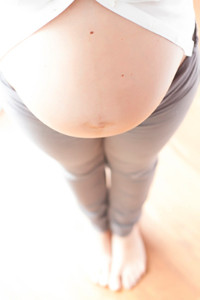 Swollen feet among pregnant women is a very common and normal condition. However, it can be very uncomfortable for women and should be monitored closely. The feet become swollen most often in the third trimester due to increased blood pressure and fluids in the lower body. The swelling tends to worsen during the day but can decrease or go away after a night of sleep. Sometimes, the swelling can spread to other parts of the body such as the thighs, hands and face. If the swelling spreads, it is important to see a doctor, as this could be a sign of potentially serious conditions. While you can’t get rid of swollen feet, consuming less salt, avoiding the consumption of too much liquid, and getting enough vitamins can help reduce the swelling. If your feet are swollen and are causing you pain, it is recommended to see a podiatrist for treatment.
Swollen feet among pregnant women is a very common and normal condition. However, it can be very uncomfortable for women and should be monitored closely. The feet become swollen most often in the third trimester due to increased blood pressure and fluids in the lower body. The swelling tends to worsen during the day but can decrease or go away after a night of sleep. Sometimes, the swelling can spread to other parts of the body such as the thighs, hands and face. If the swelling spreads, it is important to see a doctor, as this could be a sign of potentially serious conditions. While you can’t get rid of swollen feet, consuming less salt, avoiding the consumption of too much liquid, and getting enough vitamins can help reduce the swelling. If your feet are swollen and are causing you pain, it is recommended to see a podiatrist for treatment.
Pregnant women with swollen feet can be treated with a variety of different methods that are readily available. For more information about other cures for swollen feet during pregnancy, consult with Dr. Steven Shlonsky from Louisville, Kentucky. Dr. Shlonsky will attend to all of your foot and ankle needs.
What Foot Problems Can Arise During Pregnancy?
One problem that can occur is overpronation, which occurs when the arch of the foot flattens and tends to roll inward. This can cause pain and discomfort in your heels while you’re walking or even just standing up, trying to support your baby.
Another problem is edema, or swelling in the extremities. This often affects the feet during pregnancy but tends to occur in the later stages.
How Can I Keep My Feet Healthy During Pregnancy?
If you have any questions please feel free to contact our office located in Louisville, KY . We offer the newest diagnostic and treatment technologies for all your foot and ankle needs.
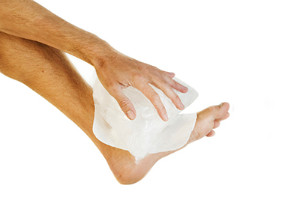 Ole Miss recently endured a big loss when they learned their shortstop had suffered a broken foot. Shortstop Greg Kessinger is expected to miss the rest of the season with the injury. Kessinger had an x-ray on his foot which revealed the fracture, however his surgery to repair it has not been scheduled. The young shortstop suffered the injury while playing ping-pong in the players lounge at the SEC Tournament. He had been the everyday shortstop all season, hitting .175, with 2 home runs, 5 doubles and 16 RBIs.
Ole Miss recently endured a big loss when they learned their shortstop had suffered a broken foot. Shortstop Greg Kessinger is expected to miss the rest of the season with the injury. Kessinger had an x-ray on his foot which revealed the fracture, however his surgery to repair it has not been scheduled. The young shortstop suffered the injury while playing ping-pong in the players lounge at the SEC Tournament. He had been the everyday shortstop all season, hitting .175, with 2 home runs, 5 doubles and 16 RBIs.
A broken foot requires immediate medical attention and treatment. If you need your feet checked, contact Dr. Steven Shlonsky from Louisville, Kentucky. Dr. Shlonsky can provide the care you need to keep you pain-free and on your feet.
Broken Foot Causes, Symptoms, and Treatment
A broken foot is caused by one of the bones in the foot typically breaking when bended, crushed, or stretched beyond its natural capabilities. Usually the location of the fracture indicates how the break occurred, whether it was through an object, fall, or any other type of injury.
Common Symptoms of Broken Feet:
Those that suspect they have a broken foot shoot seek urgent medical attention where a medical professional could diagnose the severity.
Treatment for broken bones varies depending on the cause, severity and location. Some will require the use of splints, casts or crutches while others could even involve surgery to repair the broken bones. Personal care includes the use of ice and keeping the foot stabilized and elevated.
If you have any questions please feel free to contact our office located in Louisville, KY . We offer the newest diagnostic and treatment technologies for all your foot and ankle needs.
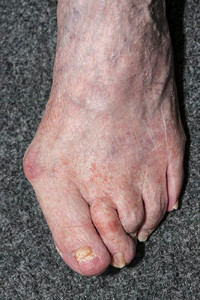 According to a surgeon on the medical staff of Lee Health, “The term bunion really implies a bump on the inside portion of the foot just behind the big toe joint.” Bunions are extremely common and some people are at a higher risk of developing them compared to others. Podiatrists say that people with flat feet are more likely to develop bunions than those with normal arches in their feet. Many podiatrists have come to the realization that bunion removal surgery isn’t very effective for those with flat feet, because the arch in the foot needs to be corrected in order to prevent more bunions from developing in the future.
According to a surgeon on the medical staff of Lee Health, “The term bunion really implies a bump on the inside portion of the foot just behind the big toe joint.” Bunions are extremely common and some people are at a higher risk of developing them compared to others. Podiatrists say that people with flat feet are more likely to develop bunions than those with normal arches in their feet. Many podiatrists have come to the realization that bunion removal surgery isn’t very effective for those with flat feet, because the arch in the foot needs to be corrected in order to prevent more bunions from developing in the future.
If you are suffering from bunions, contact Dr. Steven Shlonsky of Louisville, Kentucky. Dr. Shlonsky can provide the care you need to keep you pain-free and on your feet.
What Is a Bunion?
A bunion is formed of swollen tissue or an enlargement of boney growth, usually located at the base joint of the toe that connects to the foot. The swelling occurs due to the bones in the big toe shifting inward, which impacts the other toes of the foot. This causes the area around the base of the big toe to become inflamed and painful.
Why Do Bunions Form?
Genetics – Susceptibility to bunions are often hereditary
Stress on the feet – Poorly fitted and uncomfortable footwear that places stress on feet, such as heels, can worsen existing bunions
How Are Bunions Diagnosed?
Doctors often perform two tests – blood tests and x-rays – when trying to diagnose bunions, especially in the early stages of development. Blood tests help determine if the foot pain is being caused by something else, such as arthritis, while x-rays provide a clear picture of your bone structure to your doctor.
How Are Bunions Treated?
If you have any questions, please feel free to contact our office located in Louisville, KY . We offer the newest diagnostic and treatment technologies for all your foot care needs.
Read more about Bunions
Louisville Podiatry Office
149 Thierman Ln
Louisville,
KY 40207
Mon: 9:30 AM - 5:30 PM
Tues: 9:30 AM - 5:30 PM
Wed: 9:30 AM - 5:30 PM
Thur: 9:30 AM - 5:30 PM
Fri: 9:30 AM - 5:30 PM